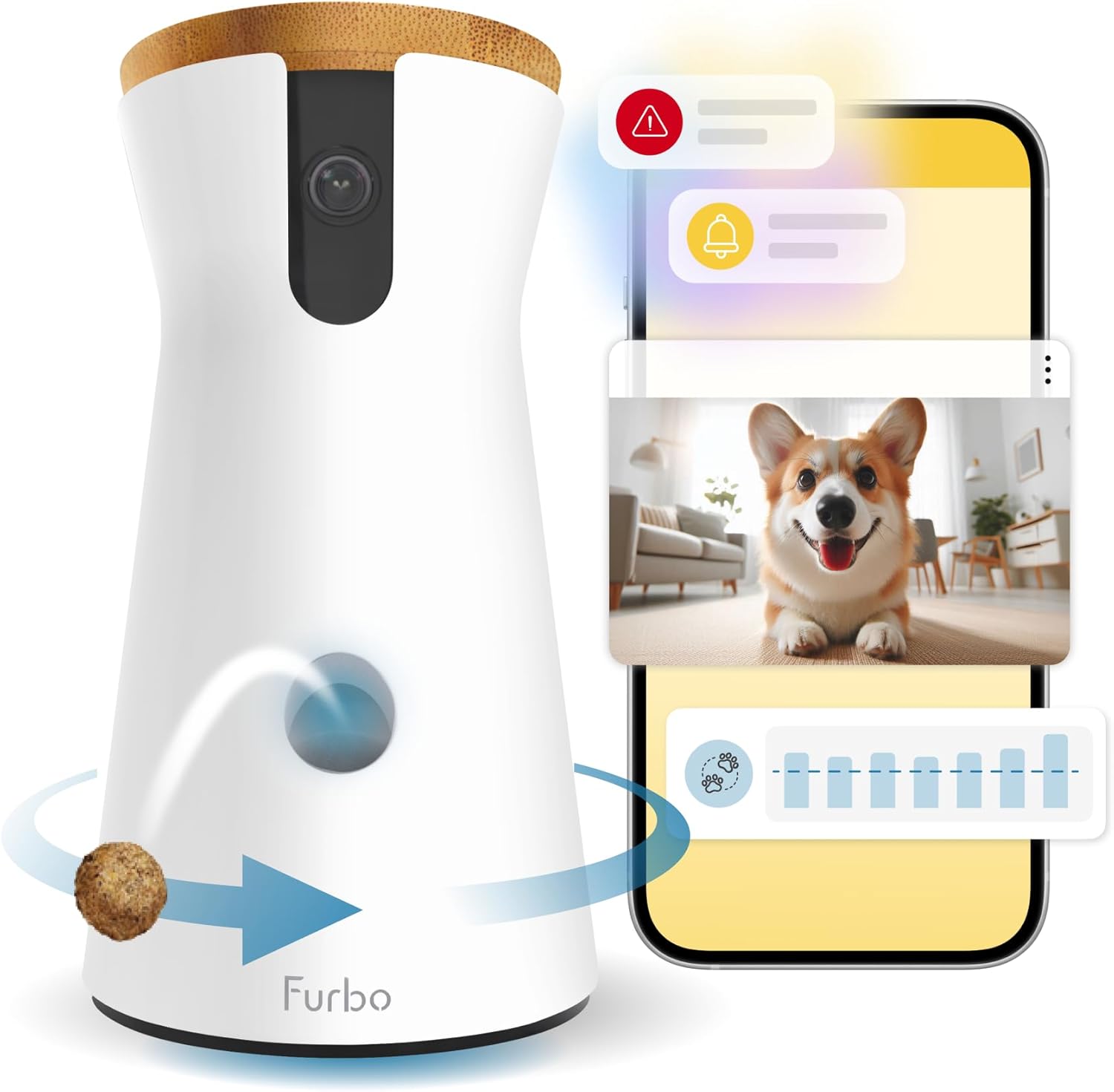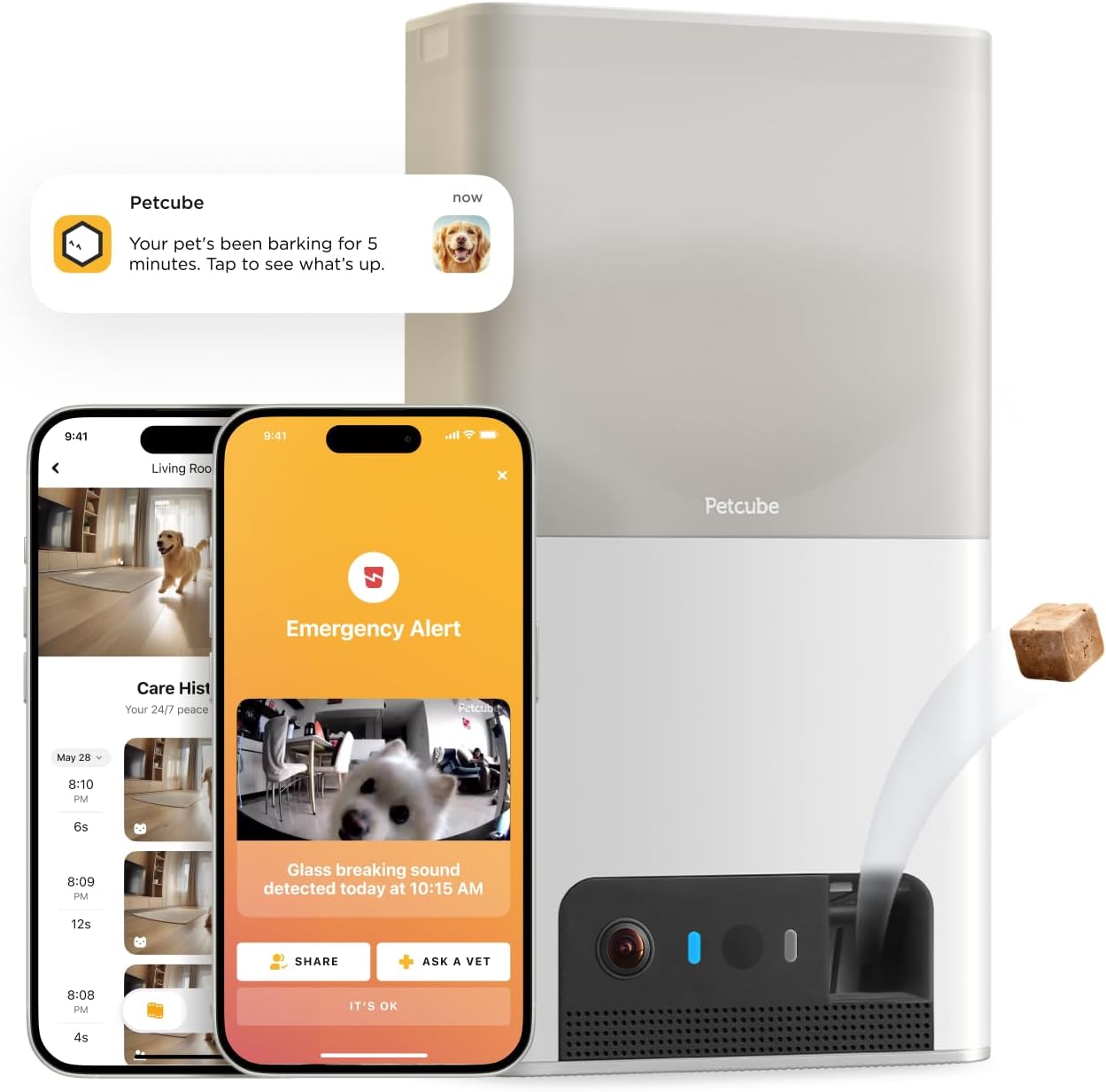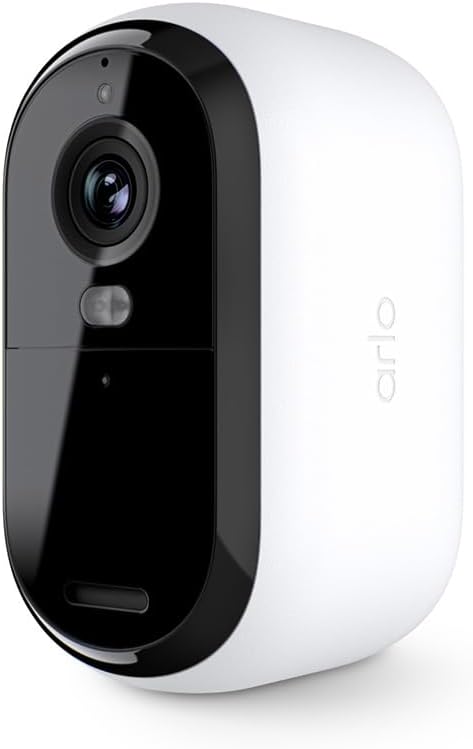How to Choose the Best Pet Camera for Monitoring Your Furry Friends
Leaving pets alone at home can be stressful — not just for them, but for you as well. Whether you’re at work, running errands, or traveling, it’s natural to worry about your furry companions: Are they safe? Are they anxious? Are they getting into trouble?
Pet cameras have become an essential solution to these concerns, bridging the gap between you and your pets when you can’t physically be there. What once seemed like a luxury item has now proven to be a valuable tool for promoting your pet’s emotional well-being, monitoring health and behavior, and even enhancing home security.
Today’s best pet cameras go beyond simple video feeds. They feature two-way audio so you can talk to and comfort your pet, motion detection alerts to keep you informed about unusual activity, treat dispensers for positive reinforcement, and night vision for round-the-clock peace of mind. Some models even use AI to recognize specific behaviors like barking, whining, or scratching, helping you address issues early.
More importantly, pet cameras strengthen the emotional bond you share with your pets. Hearing your voice or receiving a treat from you, even when you’re miles away, can ease separation anxiety and create a sense of connection that benefits both you and your animal companions.
As the demand for smarter pet care grows, so does the variety and sophistication of pet cameras available. Whether you live with a playful puppy, a curious cat, or an entire menagerie, there’s a camera perfectly suited to keeping your pets safe, entertained, and loved — no matter where life takes you.
Must-Have Features
Choosing the best pet camera means understanding which features will truly make a difference in your daily life. It’s not just about having the latest tech — it’s about picking tools that support your pet’s safety, happiness, and your peace of mind. Here’s a deeper look at the key features you should prioritize and why they matter:
Two-Way Audio: Stay Connected with Your Pets
Two-way audio allows you to listen to what’s happening at home and speak to your pet whenever needed. This can be incredibly helpful for calming an anxious animal, distracting them from destructive behavior, or simply providing reassurance during long periods of separation. When selecting a camera, it’s worth ensuring the sound quality is clear and reliable, minimizing echoes and background noise.
Motion Detection and Smart Notifications
Motion detection technology adds an important layer of security and awareness. A good pet camera will notify you when your pet is moving around, playing, or engaging in unusual behavior. Some models offer customizable sensitivity settings or even differentiate between pet motion and human movement, helping you avoid unnecessary alerts and stay better informed about what’s actually happening at home.
Treat Dispensing for Interaction and Positive Reinforcement
Treat-tossing cameras have become incredibly popular, and for good reason. Being able to reward your pet while you’re away strengthens positive behavior patterns and helps alleviate boredom. For training purposes or just for fun, treat dispensers are a valuable tool. When choosing a camera with this feature, it’s important to check if the treat container accommodates different treat sizes and whether you can adjust the tossing distance.
High-Definition Video Quality
Crisp, clear video is essential for accurately monitoring your pet’s actions and environment. Look for pet cameras that offer at least 1080p HD resolution. A wide-angle lens (typically over 120 degrees) can also ensure you capture more of the room without having to reposition the device constantly. Higher video quality helps you notice important details like changes in posture, limping, or signs of stress.
Night Vision for Around-the-Clock Monitoring
Pets are active both day and night, so reliable night vision is a critical feature. Cameras equipped with infrared night vision allow you to see clearly even in complete darkness without disturbing your pets with bright lights. This is especially important for owners who work night shifts or who want to monitor pets’ behavior while everyone is sleeping.
Zoom and Adjustable Viewing Angles
Some cameras offer zoom capabilities or pan-and-tilt functions, giving you more flexibility to focus on different areas of the room. Being able to zoom in on a specific spot, such as your pet’s bed or the doorway, can help you quickly check for issues without needing multiple devices.
Cloud Storage and Playback Options
Many pet cameras offer cloud storage plans, enabling you to save video clips and review footage later. This can be helpful for tracking behavioral patterns over time, capturing special moments, or even providing evidence if a safety issue arises. Before purchasing, check what storage options are available — some brands provide limited free storage, while others require a subscription for extended access.
Intuitive Mobile App Access
A reliable mobile app is critical for managing your pet camera effectively. Ideally, the app should offer live streaming, instant notifications, the ability to control treat dispensing, access to recorded footage, and the option to customize settings easily. Some apps even allow multiple users, which is ideal for families who all want to stay connected to their pets throughout the day.
Smart Home Integration
For households already equipped with smart home ecosystems, finding a pet camera compatible with Amazon Alexa, Google Assistant, or Apple HomeKit can add extra convenience. Voice commands can be used to access live feeds, dispense treats, or receive customized activity alerts. Integration with other smart devices can also allow for automated routines, such as turning on cameras when you leave the house.
Indoor vs. Outdoor Pet Camera Considerations
When choosing a pet camera, one of the first decisions you’ll need to make is whether you need an indoor or outdoor model. Each type serves a different purpose and comes with its own set of advantages, limitations, and technical requirements.
Indoor Pet Cameras
Indoor cameras are specifically designed for monitoring pets within the safety of your home. These cameras focus heavily on features that enhance interaction, such as treat dispensers, two-way audio, and motion tracking. They are usually compact, lightweight, and easy to install — often requiring nothing more than placing them on a shelf or mounting them to a wall.
These cameras are ideal for watching pets while you’re at work, managing separation anxiety, checking in on new puppies or kittens, and monitoring behavior issues like chewing, scratching, or excessive barking. Most indoor pet cameras also integrate easily with smart home systems, allowing for convenient control and monitoring through mobile apps.
Since they are meant for temperature-controlled environments, indoor cameras typically lack weatherproofing and robust protective casings. Exposure to moisture, dust, or extreme temperatures can quickly damage them, so they should never be used outside or in areas like open garages or patios that aren’t fully enclosed.
When selecting an indoor pet camera, consider the layout of your home and your pet’s habits. Some pets stay mostly in one room, while others roam freely. In multi-room homes, cameras with a wide-angle lens, pan-and-tilt functionality, or multi-camera systems may be necessary to provide full coverage.
Outdoor Pet Cameras
Outdoor pet cameras are built to endure harsher environments. These models come with weather-resistant or waterproof designs, durable casings, and enhanced security features. They are best suited for pet owners whose animals spend significant time outside in the yard, patio, or garden.
Besides monitoring pets, outdoor cameras often double as part of a home’s security system, offering protection against potential intruders or wildlife that could pose a risk to your animals. Many outdoor models include features like color night vision, motion-activated spotlights, and even sirens to deter threats.
Outdoor cameras generally have broader fields of view, longer-range motion detection, and stronger wireless connectivity options to maintain stable operation even at greater distances from the router. They may require a more involved installation process, including mounting brackets, weatherproof cabling, and stronger Wi-Fi or power supply setups.
When choosing an outdoor pet camera, look for a high IP (Ingress Protection) rating — such as IP65 or higher — to ensure the device can withstand rain, dust, and temperature fluctuations. It’s also helpful to find a camera with adjustable motion zones, so you can fine-tune the areas you want to monitor and avoid unnecessary notifications triggered by passing cars or swaying trees.
Hybrid Setups: Combining Indoor and Outdoor Monitoring
For households with both indoor and outdoor pets, or homes where pets move freely between spaces, a hybrid setup may be the best solution. Using a combination of indoor cameras for close-up, interactive monitoring and outdoor cameras for perimeter surveillance ensures that pets are always within view, no matter where they wander.
This approach also strengthens home security overall and allows for seamless transitions in monitoring as your pet’s habits or your household needs change over time.
| Feature | Indoor Cameras | Outdoor Cameras |
|---|---|---|
| Environment | Climate-controlled interiors | Exposed outdoor environments |
| Key Features | Two-way audio, treat tossing, motion tracking | Weatherproofing, wide field of view, enhanced night vision |
| Installation | Easy, minimal setup | Requires mounting and stable Wi-Fi |
| Durability | Moderate (not weatherproof) | High (built for tough conditions) |
| Use Cases | Behavior monitoring, separation anxiety, training | Outdoor pet safety, yard activity, home security |
Top Pet Cameras for Dogs, Cats, and Multi-Pet Homes
With dozens of options on the market, narrowing down the best pet camera can feel overwhelming. To make your decision easier, we’ve reviewed some of the top-rated models currently available — each offering a unique blend of features tailored to different pets, home setups, and budgets.
Furbo 360° Dog Camera

Best for: Dog owners who want smart alerts, barking detection, and interactive treat tossing.
Key features:
- 1080p Full HD video with 360° rotating view
- Two-way audio
- Smart barking alerts
- Adjustable treat dispenser
- Real-time app notifications
- Color night vision
Furbo is one of the most recognized brands in the pet tech world — and for good reason. This camera is specifically designed with dogs in mind. Its unique barking sensor can notify you when your dog is vocalizing more than usual, potentially indicating anxiety or distress. The treat tosser lets you remotely reward your dog or distract them from destructive behavior. The 360° pan function is excellent for tracking pets as they move across a room, especially if your dog has free roam.
Pros:
- Exceptional video quality and full-room coverage
- Dog-specific alerts and features
- Treat tossing is fun and reliable
- Sleek, minimalist design
Cons:
- Premium features (like cloud storage and AI alerts) require a subscription
- Treat compartment may not work well with larger treats
Petcube Bites 2 Lite

Best for: Multi-pet households or owners who want a treat-dispensing camera with Alexa integration.
Key features:
- 1080p HD video with 160° wide-angle lens
- Built-in Amazon Alexa voice assistant
- Treat dispensing with customizable distance
- Two-way audio
- Sound and motion alerts
- Night vision
Petcube Bites 2 Lite is a well-rounded option for homes with multiple pets. Its wide-angle lens helps cover larger areas, making it suitable for tracking several pets at once. The built-in Alexa adds voice control capabilities, letting you operate the camera with simple commands or integrate it with other smart home devices. The stainless steel treat container is durable, holds a decent amount, and works with a wide variety of treat sizes.
Pros:
- Large treat capacity
- Wide viewing angle suitable for open spaces
- Solid app experience
- Alexa integration adds convenience
Cons:
- No camera pan or tilt features
- Premium subscription required for full AI features and video history
Eufy Pet Dog Camera D605

Best for: Pet owners looking for a budget-friendly option with essential features and high reliability.
Key features:
- 1080p HD resolution with 270° wide-angle rotation
- 3x zoom capability
- Real-time motion tracking
- Treat dispenser with anti-clog design
- Two-way audio
- Local and optional cloud storage
Eufy has built a reputation for affordable yet feature-rich smart home products, and their pet camera is no exception. It offers smooth motion tracking, a clean app interface, and a clever design that allows the lens to rotate widely, helping you follow your pet’s movement across the room. The treat dispenser is simple but effective, and unlike some competitors, it’s designed to prevent clogging.
Pros:
- Great value for the price
- Smooth motion tracking and wide rotation
- Doesn’t require a subscription for basic functionality
- Easy to set up
Cons:
- No night vision in complete darkness (low-light only)
- Limited smart home integration
Wyze Cam Pan v3

Best for: Cat owners or small-pet households looking for affordable, flexible monitoring.
Key features:
- 1080p Full HD with 360° pan and 93° tilt
- Full-color night vision
- Motion and sound detection
- Motion tracking
- Free 14-day rolling cloud storage (with optional paid plans)
- IP65 weather resistance (indoor/outdoor use)
Cats are notoriously curious and independent — they’ll jump, hide, and climb into unexpected places. Wyze Cam Pan v3 is a great tool for following your feline’s movements, thanks to its fast pan-and-tilt capabilities. The camera responds to sound and motion and tracks activity automatically, ensuring your cat stays in view. While it’s not specifically a “pet camera,” it offers more flexibility than many pet-specific options and comes at a fraction of the price.
Pros:
- Excellent tracking ability
- Very affordable
- Can be used outdoors if needed
- Night vision is surprisingly sharp
Cons:
- No treat dispenser
- Basic design may not appeal to all users
Arlo Essential Spotlight Camera

Best for: Outdoor use and pets who spend time in backyards, patios, or gardens.
Key features:
- 1080p HD video with integrated spotlight
- Color night vision
- Two-way audio
- Weather-resistant (IP65)
- Motion-activated alerts and siren
- Wireless setup with rechargeable battery
Arlo’s Essential Spotlight Camera is a top-tier option for outdoor pet monitoring. Its robust construction can handle rain, heat, and wind, making it perfect for dogs that spend time outdoors or for keeping an eye on a yard or kennel area. The integrated spotlight and siren enhance visibility and security. It also connects easily with smart home systems like Alexa and Google Assistant.
Pros:
- Built for outdoor durability
- Sharp image quality, even at night
- Works well for both pets and home security
- Wire-free installation
Cons:
- No pet-specific features like treat tossing
- Requires subscription for video history and advanced detection
Installation and Security Tips
Even the best pet camera won’t be effective without the right installation and security practices. Proper setup ensures you capture the best possible footage, protect your privacy, and make daily monitoring easy and stress-free. Here’s what you should know when setting up your pet camera system.
Choosing the Right Location
The placement of your pet camera can significantly affect how useful it is. The ideal spot depends on your pet’s habits, the layout of your home, and the areas you want to monitor most closely.
For indoor cameras:
Position cameras at your pet’s eye level for the best perspective of their behavior.
Place them in high-activity areas such as the living room, kitchen, or near your pet’s sleeping or feeding spots.
Make sure the camera has an unobstructed view, avoiding obstacles like furniture or houseplants.
Choose a location near a power outlet if your camera isn’t battery-operated.
For outdoor cameras:
Mount them under eaves, patios, or other sheltered spots to minimize exposure to direct rain or sunlight, even if the device is weather-resistant.
Position outdoor cameras to cover key areas like backyards, kennels, dog runs, or access gates.
Ensure the camera’s motion detection zones are set to focus on your property, not public streets, to reduce false alarms.
Regardless of location, avoid installing cameras within reach of curious paws or playful tails, which could knock them over or block the view.
Setting Up Your Camera Correctly
Taking time to properly set up your camera will improve its performance and longevity.
Connect your camera to a stable Wi-Fi network with good signal strength in the area where it will be placed. For outdoor or large homes, a Wi-Fi extender may be necessary.
Adjust the camera angle so it captures as much of the room or yard as possible without too much ceiling or ground space.
Test both live streaming and recording features before finalizing the camera placement to ensure smooth operation and visibility.
Enable motion and sound detection settings appropriate for your pet’s size and activity level to avoid excessive alerts.
Regularly clean the camera lens with a soft microfiber cloth to maintain clear video quality, especially for outdoor units exposed to dust or moisture.
Securing Your Pet Camera from Hackers
While pet cameras bring tremendous convenience, they can also pose privacy risks if not properly secured. Protecting your camera against unauthorized access is essential.
Always change the default username and password during setup. Choose a strong password that combines letters, numbers, and special characters.
Enable two-factor authentication (2FA) whenever the app or service offers it. This adds an extra layer of protection, requiring a code sent to your mobile device in addition to your password.
Keep your camera’s firmware and the companion mobile app updated. Manufacturers release updates to fix security vulnerabilities and improve performance.
Use a secure, encrypted Wi-Fi network (preferably WPA3) and avoid connecting your pet camera to public or unsecured networks.
Consider setting up a separate Wi-Fi network just for smart devices, isolating them from your main personal devices like laptops and phones.
Taking these steps significantly reduces the risk of hacking, ensuring that only you and authorized family members have access to the camera feed.
Managing Notifications and Storage Settings
Customizing your notifications and video storage settings can make your pet monitoring experience smoother and more efficient.
Set motion zones to focus on areas where your pet usually stays, minimizing alerts triggered by irrelevant movement.
Adjust alert sensitivity if you have small pets like cats or rabbits, who might not trigger default motion settings.
Choose a storage plan based on your needs: live view only, short video clips stored in the cloud, or continuous recording to a local SD card.
Regularly review stored videos to clear unnecessary clips and optimize your storage space.
Organizing these settings upfront saves time and ensures you only receive important updates about your pet’s activity.
Conclusion
A pet camera is much more than a surveillance tool — it’s a bridge that keeps you connected to your pets’ emotional and physical well-being, even when you’re away. As pet ownership evolves alongside technology, having a reliable way to monitor, interact with, and care for your animals remotely has become an essential part of responsible pet parenting.
When choosing the right pet camera, prioritize features that directly meet your needs. For active dogs, focus on treat dispensers and barking alerts. For curious cats, a wide-angle lens and motion tracking are invaluable. If your pets spend time outside, a weatherproof, durable outdoor camera should be on your checklist. Always think about where and how you’ll use the device day-to-day — the best camera is the one that fits seamlessly into your lifestyle without becoming a hassle to maintain.
Once you’ve selected and installed your pet camera, take a few additional steps to maximize its benefits:
Regularly check the camera’s positioning to ensure it still captures the areas your pets frequent most.
Update firmware and app software promptly to maintain security and access new features.
Use two-way audio to build positive associations with the camera, making your voice a source of comfort rather than confusion.
Monitor activity trends over time. Noticing subtle changes in behavior early can help you address potential health issues or environmental stressors before they escalate.
Pet cameras can also become powerful tools for training, routine-building, and even enhancing enrichment activities when paired with treat dispensing or scheduled interaction times.
Ultimately, investing in a high-quality pet camera isn’t just about convenience; it’s about giving your pets a better, safer, and more emotionally connected life. Whether you’re at work, traveling, or just out for a few hours, you can trust that a glance at your phone will instantly bring you closer to your furry friends.

